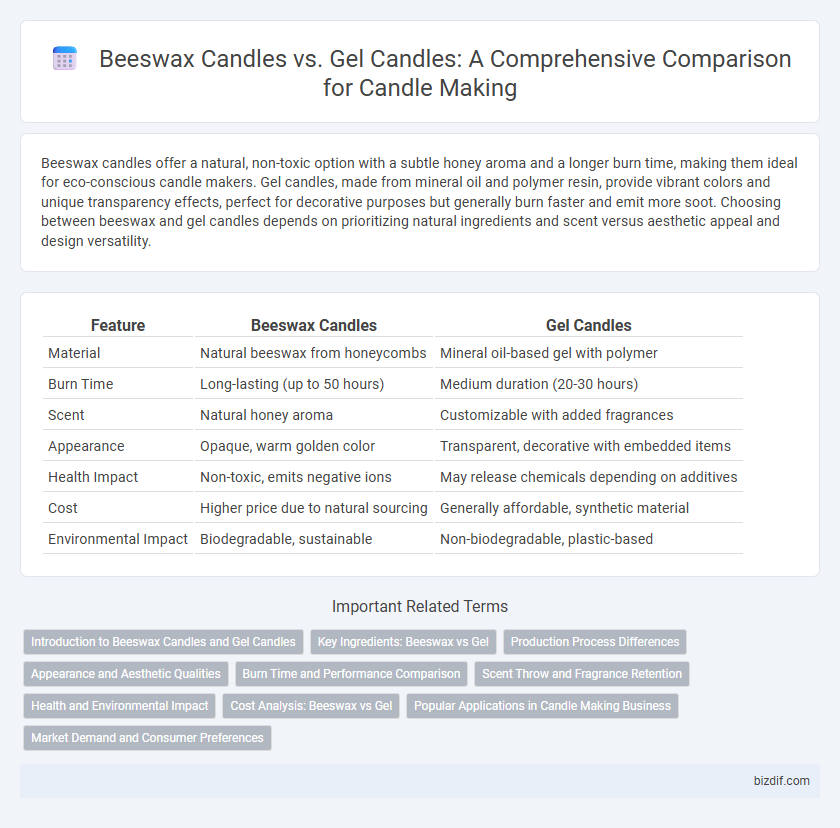Beeswax candles offer a natural, non-toxic option with a subtle honey aroma and a longer burn time, making them ideal for eco-conscious candle makers. Gel candles, made from mineral oil and polymer resin, provide vibrant colors and unique transparency effects, perfect for decorative purposes but generally burn faster and emit more soot. Choosing between beeswax and gel candles depends on prioritizing natural ingredients and scent versus aesthetic appeal and design versatility.
Table of Comparison
| Feature | Beeswax Candles | Gel Candles |
|---|---|---|
| Material | Natural beeswax from honeycombs | Mineral oil-based gel with polymer |
| Burn Time | Long-lasting (up to 50 hours) | Medium duration (20-30 hours) |
| Scent | Natural honey aroma | Customizable with added fragrances |
| Appearance | Opaque, warm golden color | Transparent, decorative with embedded items |
| Health Impact | Non-toxic, emits negative ions | May release chemicals depending on additives |
| Cost | Higher price due to natural sourcing | Generally affordable, synthetic material |
| Environmental Impact | Biodegradable, sustainable | Non-biodegradable, plastic-based |
Introduction to Beeswax Candles and Gel Candles
Beeswax candles, made from natural bee-produced wax, offer a clean burn with a subtle honey aroma and emit fewer toxins compared to paraffin candles. Gel candles, composed of mineral oil and polymer resin, provide a visually striking translucent appearance and can be embedded with decorative items for enhanced aesthetic appeal. Both types present unique benefits for candle makers emphasizing natural ingredients or creative design elements.
Key Ingredients: Beeswax vs Gel
Beeswax candles are made from natural beeswax, a renewable resource produced by honeybees that offers a clean burn and emits a subtle honey fragrance. Gel candles are crafted from mineral oil and polymer resin, creating a translucent, flexible material that allows for decorative embeds and vibrant colors. The inherent difference in key ingredients influences burn time, scent throw, and environmental impact, with beeswax being biodegradable and gel candles typically synthetic.
Production Process Differences
Beeswax candles are crafted by melting natural beeswax harvested from honeycombs, which is then poured into molds or hand-rolled, relying on organic filtration without synthetic additives. Gel candles require a mixture of mineral oils and polymer resin, heated to form a translucent gel that solidifies around embedded decorative elements, demanding precise temperature control to avoid cloudiness. The beeswax process emphasizes purity and natural extraction, while gel candle production involves synthetic compounds and careful thermal management to achieve clarity and texture.
Appearance and Aesthetic Qualities
Beeswax candles boast a natural, warm golden hue that enhances rustic and elegant settings with a subtle honey aroma, offering a timeless and organic aesthetic. Gel candles feature a translucent, glass-like appearance allowing vibrant colors and embedded decorative elements to shine, creating modern and visually striking designs. The choice between beeswax and gel candles hinges on whether a classic, natural look or a customizable, contemporary aesthetic is desired.
Burn Time and Performance Comparison
Beeswax candles burn longer than gel candles, with an average burn time of 40-60 hours compared to gel candles' 20-30 hours. Beeswax produces a brighter, cleaner flame with minimal soot, enhancing indoor air quality, while gel candles often emit more smoke and can be less consistent in burn performance. The high melting point of beeswax contributes to its slow, steady burn, making it a preferred choice for longevity and efficient use.
Scent Throw and Fragrance Retention
Beeswax candles naturally emit a subtle, honey-like aroma that enhances their scent throw without overpowering a space, while gel candles offer a stronger, more customizable fragrance experience due to their clear base allowing higher fragrance oil load. Beeswax's dense composition retains fragrances moderately but tends to diffuse scent more evenly and gently over time. Gel candles, with their unique polymer base, provide a potent scent throw and maintain fragrance intensity longer, making them ideal for vibrant, long-lasting aromas in scented candle production.
Health and Environmental Impact
Beeswax candles emit natural, non-toxic compounds that improve indoor air quality and provide hypoallergenic benefits, making them a healthier option compared to gel candles, which can release toxic chemicals and synthetic fragrances when burned. From an environmental perspective, beeswax is a renewable, biodegradable resource produced by bees, supporting ecosystem health, whereas gel candles often contain petroleum-based mineral oils that contribute to environmental pollution and are non-biodegradable. Choosing beeswax candles reduces exposure to harmful pollutants and minimizes ecological footprint, supporting sustainable consumer practices.
Cost Analysis: Beeswax vs Gel
Beeswax candles typically cost more due to their natural sourcing, higher melting point, and longer burn time, making them a premium choice for eco-conscious consumers. Gel candles, made from mineral oil and polymer resin, are generally less expensive but offer a shorter burn duration and lower heat resistance. Evaluating cost-effectiveness involves balancing initial price with longevity and quality, where beeswax often provides greater value despite higher upfront costs.
Popular Applications in Candle Making Business
Beeswax candles are favored in the candle making business for luxury and eco-friendly product lines due to their natural aroma, clean burn, and hypoallergenic properties, often used in aromatherapy and premium gift sets. Gel candles appeal to decorative candle makers with their transparency and versatility, allowing for colorful embeds and unique shapes ideal for event decor and custom orders. Both types cater to distinct market demands, where beeswax targets health-conscious consumers and gel candles enhance visual aesthetics and creative design options.
Market Demand and Consumer Preferences
Beeswax candles maintain strong market demand due to their natural, eco-friendly properties and appealing honey scent, attracting consumers seeking sustainable and health-conscious options. Gel candles capture a niche market with customizable aesthetics and vibrant colors, appealing to buyers prioritizing decorative variety and long burn times. Consumer preferences increasingly favor beeswax for its purity and air-purifying benefits, while gel candles remain popular among those valuing visual novelty and creative design in home decor.
Beeswax candles vs Gel candles Infographic

 bizdif.com
bizdif.com